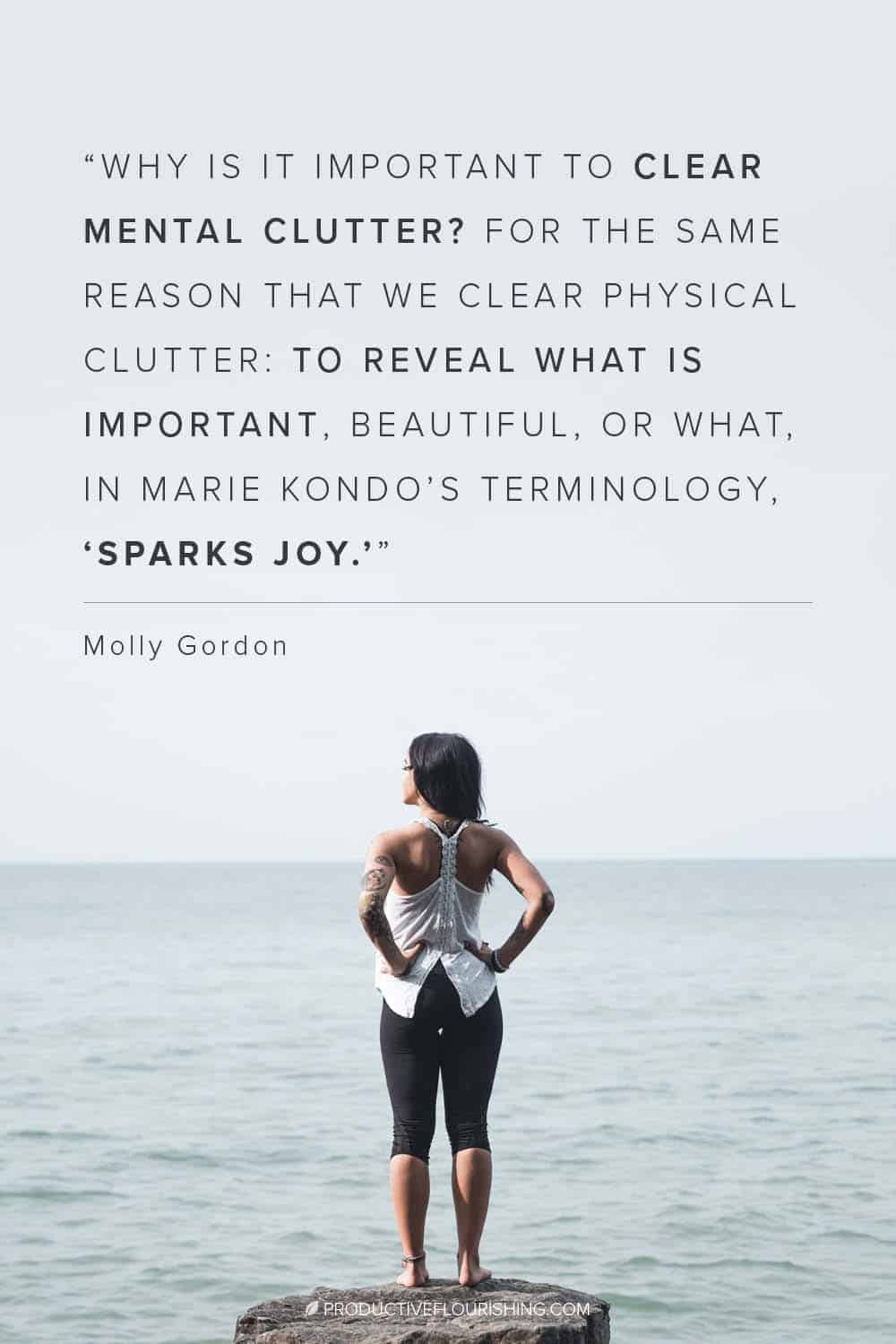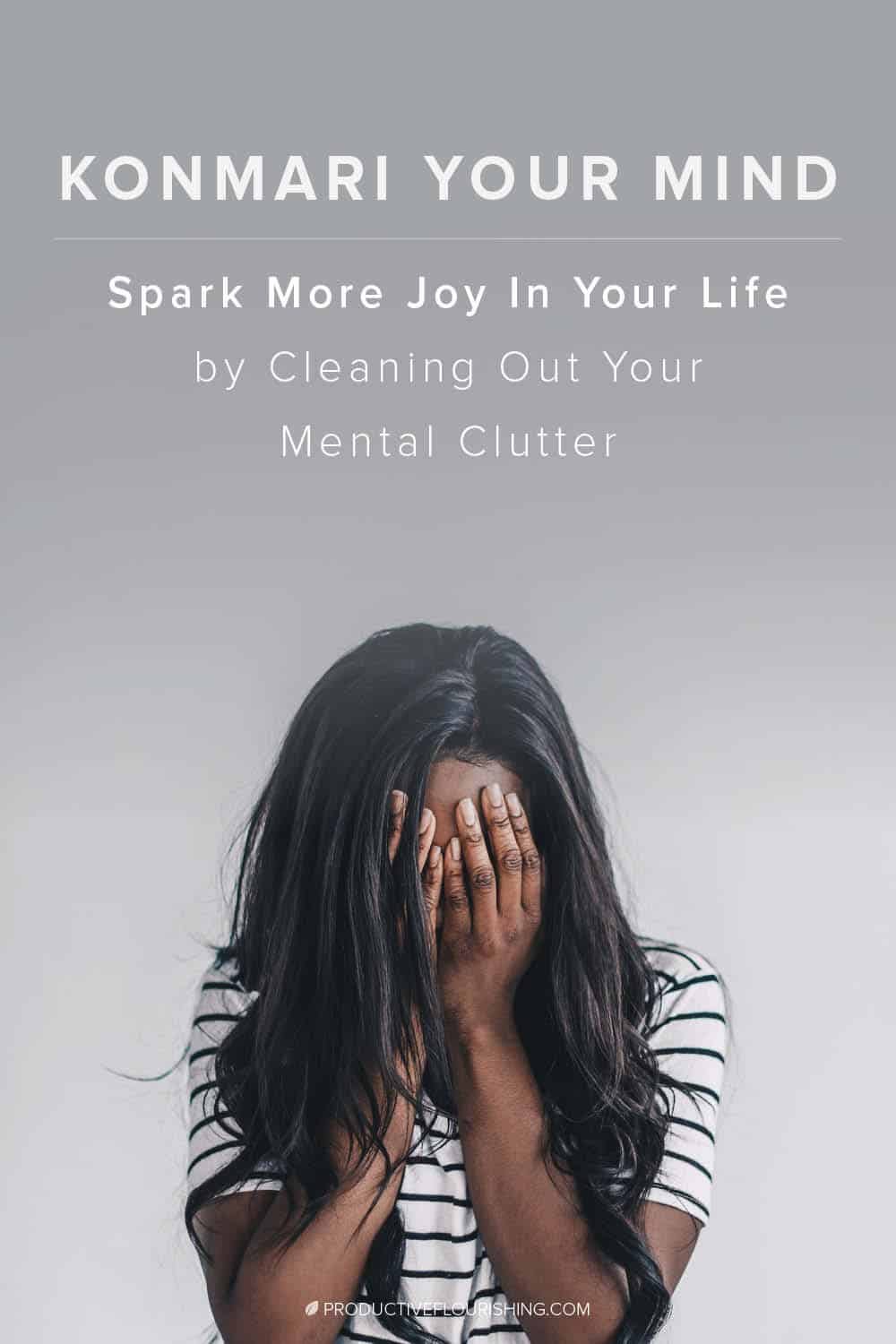How to KonMari Your Mental Clutter

Editor’s Note: This is a guest post by Molly Gordon.
Marie Kondo’s KonMari approach to transforming cluttered homes into havens of peace and contentment has captured imaginations worldwide. If we look to the heart of her approach, we’ll find principles that work equally well for clearing mental clutter. (Tweet this.)
Why is it important to clear mental clutter? For the same reason that we clear physical clutter: to reveal what is important, beautiful, useful, or what, in Kondo’s terminology, “sparks joy.” Mental clutter obscures our innate wisdom, creativity, and resilience. The freer your mind is from mental clutter, the more bandwidth you have for responding in each moment to what is actually arising in that moment. As your mind quiets, you find yourself more open, relaxed, and resourceful.
Don’t take my word for this. Think over your own experiences of mental clutter and clarity, and notice the difference in the quality and quantity of your mental activity when you’ve been stuck and when you’ve been in flow. For the moment, let go of fretting about how to manage your mental activity and simply appreciate the relationship between your state of mind and your overall clarity and effectiveness. So far, everyone I’ve invited to reflect on their experiences has found that when they settle down and allow their minds to clear, their productivity, creativity, and ability to connect and collaborate goes up. (If you see something different, by all means let me know in the comments.)
Once you’ve seen the utility of a relatively clearer, quieter mind, the question naturally arises, “How do I get that?” Let’s turn to the KonMari method for a few tips.
Begin by Connecting and Appreciating What Is
Marie Kondo begins each decluttering engagement by finding a spot in the home where she centers, connects with the spirit of the home, and spends a few moments in gratitude and connection. It’s a profoundly practical place to begin because it taps into the invisible power of intention, connection, and clarity.
You can begin in the same way when decluttering your mind. When you experience symptoms of mental clutter, things like confusion, analysis paralysis, anxiety, pressure, etc., pause. Without trying to change anything inside or out, stop, connect with yourself — the self that exists before and beyond the noise of your thinking — and appreciate the glorious mental mess. On the face of it, that may seem to be a stretch, especially if you’re wanting to escape or avoid the mess. The key is to let go for a moment of your judgments and concerns about the mess and notice instead the wealth of possibility that it represents. Isn’t it amazing that your mind is capable of generating such abundance? Switching your attention from the content of your thinking (the difficult feelings) to the fact that your thinking is endlessly creative, changes your relationship to mental clutter.
Recognize You Don’t Have to Believe Everything You Think
When it comes to decluttering your mind, believing everything you think is the correlate of keeping everything you’ve accumulated until your home looks like a flea market. The result is that you can’t find what you need when you need it, and there’s no room for anything new. The good news is that, just as you don’t have to keep everything you buy, you don’t have to believe everything you think.
More good news: you are already quite good at not believing everything you think. Thousands and thousands of thoughts move through your mind every day without taking up residence or leaving a mark. You’re probably not aware of them precisely because you haven’t given them much attention. For example, as a longtime fan of detective stories I sometimes fantasize about pulling off the perfect crime, but I’ve never once worried that I might actually rob a bank.
Like me, you probably have many areas of your mental life where you already comfortably distinguish between what’s worth taking seriously and what’s not. However, unless you are a fully enlightened being, there are likely some areas in which you don’t yet realize that you’re cluttering your mind with ideas and concerns and beliefs you don’t have to believe. PRODUCTIVE FLOURISHING
Recognize Feelings as a Barometer for Discerning What Thoughts to Believe
In Kondo’s system, clients go through their possessions one at a time, touching each one and asking, “Does this spark joy?” If the answer is no, the item goes to a discard pile. If the answer is yes, it gets lovingly folded and intentionally stored. Given that we have between 30,000 and 100,000 thoughts a day, most of which never make it to our conscious minds, it doesn’t make sense to try to “touch, store, and fold” all those thoughts. Fortunately, you don’t have to. Like every other human being, you have an internal sorting mechanism, a built-in barometer you can use to discern helpful from unhelpful thinking. That barometer is your feelings.
Feelings indicate the relative clarity and utility of your thinking in the moment. Feelings arise with every thought. Feelings such as clarity, connection, compassion, and openness are typical companions of clear and creative thinking. Feelings like anxiety, envy, pressure, and resentment are typical companions of cloudy and stuck thinking. Rather than getting caught up in whether or not you like how you are feeling, use your feelings as a barometer to recognize where it makes sense to put your mental energy.
I’ll say that again: rather than reacting to how you feel, let how you feel help you discern helpful from unhelpful thinking.
Case Study: Lou
Here’s how my client Lou (a pseudonym) discovered her internal barometer and used it to shift from anxiety-ridden paralysis to productivity.
Lou was trying to bring a new product to market and had a history of being derailed by anxiety. I asked her, “What do you think your anxiety is telling you that is worth listening to?” She trotted out a litany of insecure thoughts: no one will want this, I’m not sure this will work, I don’t want to embarrass myself, I’m not actually good enough to pull this off, etc.
I asked: “What if your feelings aren’t giving you information about your potential, value, or ability? What if your feelings are information about the quality and utility of your thinking?”
Lou pushed back, arguing that the intensity of her anxiety was evidence that she had to take it seriously. I invited her to question that belief. What if the intensity of her anxiety was the result of how seriously she was taking her thoughts and feelings and didn’t actually have anything to do with their objective validity? What if the key to getting past her anxiety was not to manage or minimize it, but to simply decline to be impressed by it?
Lou left the session open to the possibility of having a different relationship with her anxiety. The next time she started to spiral into anxiety, she entertained the possibility that anxiety wasn’t giving her information about herself but about the flow of thought in the moment. Instead of reacting to anxiety, she wondered about not being impressed by it. And as she was wondering, she had an idea for packaging her new product. She turned her attention to that, and the anxiety dissipated in the background.
Over time, Lou became more and more comfortable with the experience of anxiety. Because it didn’t impress her anymore, it couldn’t derail her for long.
Mental Decluttering Is Elusive Only Because It Is so Simple
The principles of mental decluttering are so simple that you may be tempted to discount them. Please don’t. For the sake of expanding your access to wisdom, insight, and flow, try on the understanding. Here again are the principles:
When besieged by mental clutter, pause. Connect with yourself, your true self before and beyond the clutter of thought in the moment, and allow yourself to appreciate what you find in that connection.
As you go about your day, remember you don’t need to believe everything you think.
As feelings arise, let them inform you about the quality and clarity of your thinking in that moment.
Share Your Experience
While the principles of mental decluttering are universal, their application is highly variable. Let me know how you are experimenting with mental decluttering. What’s working? Where are you getting stuck? I look forward to hearing from you!





